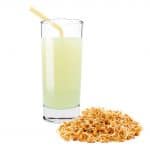Description
This rejuvelac recipe uses un-sprouted grains but many people feel that unsprouted grains lend it an unpleasant flavour. So, you will find many recipes of rejuvelac using sprouted grains, especially sprouted wheat berries. You can experiment with both: sprouted and unsprouted grains. Proponents of sprouted recipes feel that sprouting gives the drink a better flavour that will remind you of lemons and cheese.
Ingredients
- 1 cup wheat berries
- 3 cups filtered or spring water
- Glass jar with wide mouth
- Freshly cut wheatgrass (optional)
Instructions
- Wash and scrub the wheat berries under tap water. Remove residue if any. The dead seeds or berries will float to the top. Discard them as they do not promote fermentation.
- Now you have to soak the berries for at least 2 days. This process will soften them.
- Place freshly cut wheat grass on top of the water used for soaking. You can remove this wheat grass each day when you filter the rejuvelac. Replace it with freshly cut wheatgrass.
- After 2 days, filter the rejuvelac. It can be used up that day, either for cooking or drinking. You can keep it at room temperature for about a day.
- Pour another 2 cups of filtered water in the jar and allow it to ferment for one day only. Pour and use the rejuvelac that day for cooking or drinking.
- Repeat these 1-day (24 hours) fermentation cycles twice. This means, you can soak each batch of wheat berries for a total of 3 times.
Notes
Use a cool, dark place for fermentation. The ambient temperature of the place where you keep your jar is an important factor in this process.
In the summer months, you can reduce fermentation times. During summer you can soak the seeds for 36 hours instead of 48 hours and then do 2 more cycles of 16 hours instead of 24 hours.
Experiment making rejuvelac with sprouted grains. You can also vary the grains and use millets, oats, rice, barley, rye, or buckwheat.
The basic recipe of rejuvelac is very simple: 1 part organic seeds and 3 parts filtered water or spring water. Fermenting time remains the same for all seeds.
Use organic seeds only as far as possible so that there are no traces of chemicals. Squeeze half a lemon or lime in the rejuvelac for additional flavour.
Lemon/lime juice will also act as a preservative and help the rejuvelac last longer. Use the spent seeds or grains to bake ‘live breads’.
- Prep Time: 10 minutes

